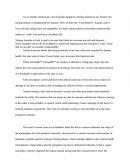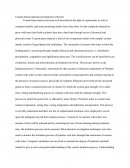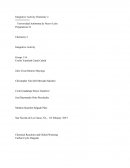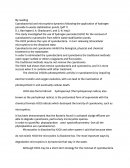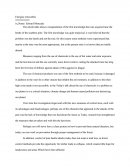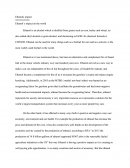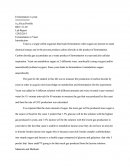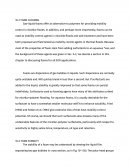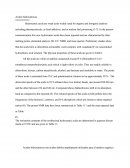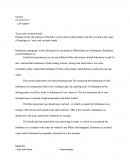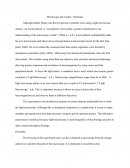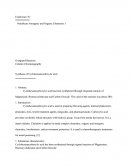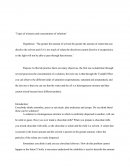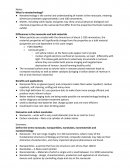Chemistry
-
Animal Testing in Food Branch
As we already mentioned, a lot of people disapprove testing animals at any branch; but testing animals is fundamental for humans. Now we have the "Food Branch"; humans can´t live at all just eating fruits and vegetables, our body needs proteins and another elements that makes us "work" fine and
Rating:Words: 552 • Pages: 3 -
Cement Based Materials Development with Time
Cement-based materials development with time Cement-based matrix has been well described in the light of experiments as well as computer models, and some promising studies have been done, by that composite material to grow with time from fresh to plastic then into a hard state through series of chemical and
Rating:Words: 397 • Pages: 2 -
Chemical Reactions and Global Warming
Integrative Activity Chemistry 2 ========== Universidad Autónoma de Nuevo León Preparatoria 16 Chemistry 2 Integrative Activity Group: 116 Evelin Yamileth Cantú Cabral Julio Cesar Ramiro Mayorga Christopher Iván Del Mercado Sánchez Cielo Guadalupe Reyes Gutiérrez José Raymundo Ortiz Ruvalcaba Melanie Querube Salgado Páez San Nicolás de Los Garza, N.L, 10/
Rating:Words: 939 • Pages: 4 -
Cyanobacterial and Microcystins
My reading Cyanobacterial and microcystins dynamics following the application of hydrogen peroxide to waste stabilisation ponds. (pdf 1) D. J. Barrington1, A. Ghadouani1, and G. N. Ivey2: This study investigated the use of hydrogen peroxide (H2O2) for the removal of cyanobacteria cyanotoxins from within waste stabilization ponds. The H2O2
Rating:Words: 3,240 • Pages: 13 -
Energias Renovables
Energias renovables ========== Name: Edward Moncada The article talks about a recapitulation of the first knowledge that was acquired near the beetle of the southern pine. The first knowledge was quite empirical, it was believed that the problem was the beetle and not the tree, for this reason some methods
Rating:Words: 361 • Pages: 2 -
Ethanol´s Impact on the World
Ethanols impact ========== Ethanol´s impact on the world Ethanol is an alcohol which is distilled from grains such as corn, barley and wheat, its also called ethyl alcohol or grain alcohol, and shortening as EtOH. Its chemical formula is C2H5OH. Ethanol can be used for many things such as a
Rating:Words: 418 • Pages: 2 -
Fermentation in Yeast
Fermentation in yeast ========== Alicia Portillo BIO 111-09 Lab Report 12/02/2015 Fermentation in Yeast Introduction: Yeast is a single celled organism that leads fermentation when sugars are present to make chemical energy and in the process produce carbon dioxide as the product of fermentation. Carbon dioxide gas accumulates as a
Rating:Words: 302 • Pages: 2 -
Gas-Liquid Foams
10-1 FOAM FLOODWG Gas-liquid foams offer an alternative to polymers for providing mobility control in micellar floods. In addition, and perhaps more importantly, foams can be used as mobility control agents in miscible floods and well treatment and have been both proposed and field tested as mobility control agents
Rating:Words: 937 • Pages: 4 -
Hydroxamic Acids
Acidos hidroxámicos ========== Hydroxamic acids are weak acids widely used for organic and inorganic analysis including pharmaceuticals, as food additives, and in nuclear fuel processing (1-7). In the present communication five new hydroxamic acids have been reported and are characterized by their melting points, elemental analysis, IR, UV, NMR, and
Rating:Words: 3,806 • Pages: 16 -
Ionic and Covalent Bonds
Vernier ========== Lab report 6 “Ionic and covalent bonds” Purpose of lab: the purpose of the lab 6 ( ionic and covalent bonds) was that you know the types of bondings in “ionic and covalent bonds “. Intrductory paragraph: in this lab report we are going to differentiate two Substances,
Rating:Words: 605 • Pages: 3 -
Microscopy and Aseptic Technique
Microscopy and Aseptic Technique Although Robert Hooke was the first person to publish work using a light microscope, Antony van Leeuwenhoek, is “considered to have made a greater contribution to our understanding of the microscopic world” (“What is,” n.d.). Leeuwenhoek confidentially made his own microscopes and observed several specimens at
Rating:Words: 640 • Pages: 3 -

Post Combustion Capture of Co2
CHEE3020 Project Two – Post Combustion CO2 Capture Cover Post Combustion Capture of CO2 ________________ 1. Table of Contents Summary vi 1.0 Introduction 1 1.1 Background 1 1.2 Alternative Technologies 2 1.3 Raw Materials 5 1.4 Process Goals 7 1.5 Process Description 9 1.6 Process Structure 11 1.7 Hazards and
Rating:Words: 20,205 • Pages: 81 -
Representative Diagram of the Carbon Cycle
A) Representative diagram of the carbon cycle CARBON CYCLE B) A brief explanation of each step of the process Through photosynthesis, plants transform atmospheric CO2, or water, into organic matter (carbohydrates, lipids, proteins and nucleic acids), from which the living beings feed through the food chains, where it becomes
Rating:Words: 698 • Pages: 3 -
Synthesis of Cyclohexanecarboxylic Acid
Expérience 3C ========== Praktikum Anorganic and Organic Chemestry I Gringnard Reaction Column Chromatography Synthesis of Cyclohexanecarboxylic acid ________________ 1. Abstract Cyclohexanecarboxylic acid has been synthetized through Grignard reaction of Magnesium, Bromocyclohexane and Carbon Dioxide. The yield of the reaction was about 38%. 1. Introduction Cyclohexanecarboxylic acid is used in preparing
Rating:Words: 449 • Pages: 2 -
The Electrolytes Lab Report
The Electrolytes Lab Report Miss: Ruth Correa Group: 118 Name: ID: Jesús Enrique Duque 1794356 Mabely Alejandra Galván Ramírez 1805820 Melissa Castañeda Lara 1806684 Samantha Flores Villarreal 1804777 Armando Betancourt Delgado 1796580 03/01/16 https://scontent-lax3-1.xx.fbcdn.net/hphotos-xal1/v/wl/t34.0-12/12781975_956399291080602_1570159866_n.jpg?_nc_eui=ARhxJr7jLyenQ2XrWNyPOHTOE_iCi10rLsLXounYkPQXlTCg2d2wHb6HzeCI&oh=0d398688246d528e7d220475e142d41a&oe=56D81C76 Objective In this practice we will identify if the liquid we have can be an electrolyte,
Rating:Words: 772 • Pages: 4 -
Types of Mixtures and Concentration of Solutions
¨Types of mixtures and concentration of solutions¨ Hypothesis: ¨The greater the amount of solvent the greater the amount of solute that can dissolve the solvent and if it is too much of solute the dissolvent cannot dissolve it (suspension), so the light will not be able to pass through
Rating:Words: 3,273 • Pages: 14 -
What Is Nanotechnology?
Notes: What is nanotechnology? * Nanotechnology is the control and understanding of matter at the nanoscale, meaning dimensions between approximately 1 and 100 nanometres. * Matter, including solids liquids and gases may show unusual physical, biological and chemical properties at the nanoscale that differ from the properties that bulk materials
Rating:Words: 750 • Pages: 3
